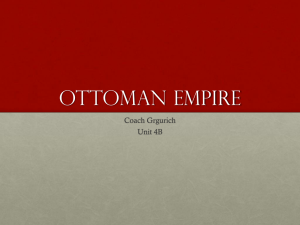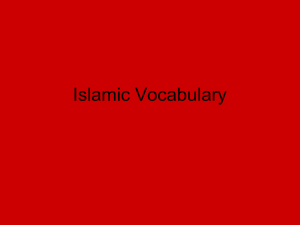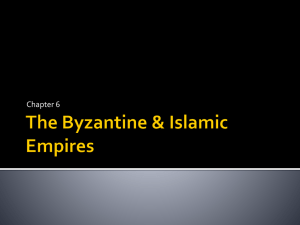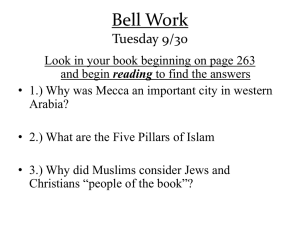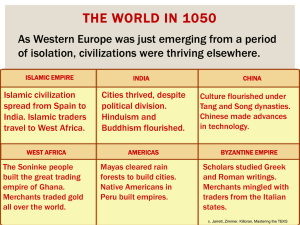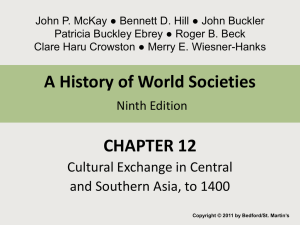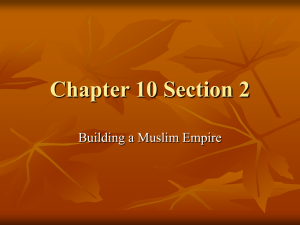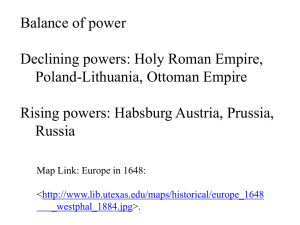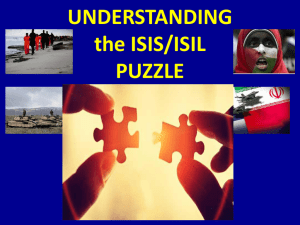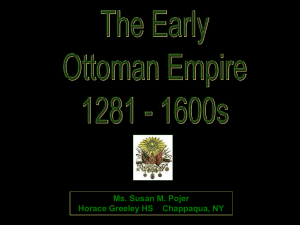Unit 5: Africa & the Islamic World
advertisement
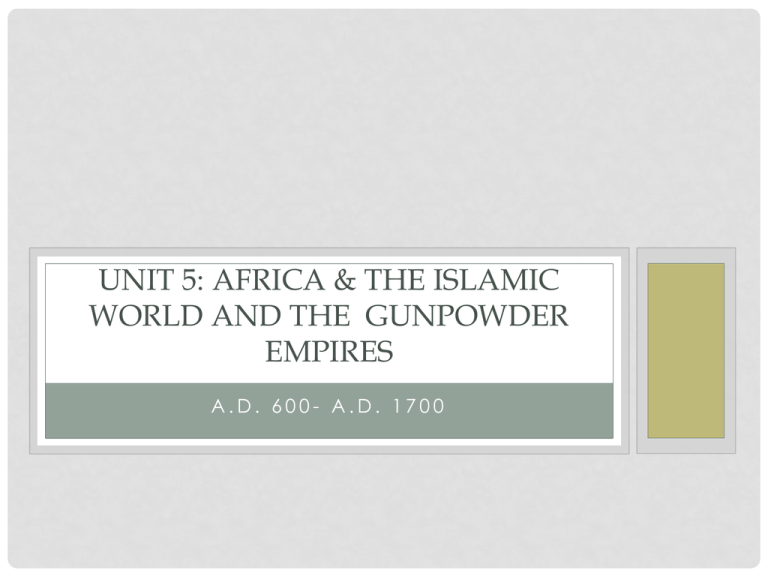
UNIT 5: AFRICA & THE ISLAMIC WORLD AND THE GUNPOWDER EMPIRES A.D. 600- A.D. 1700 THE RISE OF ISLAM • In the beginning, Arab people lived in an area called the Arabian Peninsula. ARABIAN PENINSULA • Location is about where Africa, Asia, and Europe meet. These three continents influenced their culture to this region. CAN YOU DESCRIBE THE GEOGRAPHY? What is the main environment? Was life easy or difficult? Explain. What type of people lived on the dessert? What were they in search of? Be specific. BEDOUINS • Overtime, the nomadic people, called the Bedouins, began to live in towns and cities. • People who lived in towns engaged in local and long distance…..? (previous and repeated knowledge) TRADE TRADE • Early 600s, trade had become important activity in the Arabian Peninsula, • Merchants from the Byzantine and Sassanid empires to the north brought goods to Arabia. • Spices, goods, and especially….. New ideas RELIGION OF THE AREA • At the time Arab people believed in many gods. • Religion pilgrims came to Mecca (important trading city)to worship at an ancient shrine called the Ka’ab. • It contained more than 360 idols brought there by several tribes. WHO MIGHT THIS BE? MUHAMMAD 1. 2. 3. 4. 570 A.D. birth of Muhammad He was part of the Arab society Born into a powerful family of Mecca Orphaned at the age of six and received no schooling 5. Became a successful merchant 6. Interested in religion due to his difficult life 7. At the age of 40, he took religion as his life’s mission. • One night the angel Gabriel told him to proclaim the word of God to his people. MUHAMMAD’S TEACHINGS • One God- Allah • His religion was called Islam • His followers took the name of Muslims • He converted family and friends • He began to preach it public. • Many people rejected his teachings, Why? • for they feared Meccans would neglect traditional Arab gods. • Muhammad was forced to leave Mecca for Yathrib (later called Medina) in 622. • Muhammad became a political leader of Yathrib. MECCA AND MEDINA • Mecca and Medina fought several battles over the next few years. • Gradually Muhammad and his followers gained power. • Mecca faded away as war raged on • In 630 A.D., the leaders surrendered to Muhammad. • So what would you do next if you were Muhammad (think religion)? He destroyed the Ka’ab • The people of Mecca converted to Islam. • Most of the Arabian Peninsula was under Islam influence before Muhammad died in 632 A.D. WHAT DOES THIS PICTURE REPRESENT OTHER THAN ISLAM? What Are The Five Pillars Of Islam? (Click on question) FIVE PILLARS OF ISLAM • Why do you think the Muslims have fife duties that need to be performed during their lifetime? • The duties show a person’s accepting of the will of God. • Please see page 125 in your TEKS book and take notes on the five pillars WHAT IS THIS PICTURE? QURAN • The central ideas of the Muslim religion are founded in the Quran, which Muslims believe to be the will of ALLAH as revealed to Muhammad. • It is written in Arabic – the official language of Islam Watch video to compare the Bible to the Quran How Does The Quran Compare To The Bible? SAME GOD WORSHIPED AMONG THE MAIN RELIGIONS • Muslims believe that Allah is the same God that Jews and Christians worship. • To Muslims, the Quran perfects the earlier teachings of God founded in the Jewish Torah and the Christian Bible. • Because their holy books were related to the Quran, Jews and Christians enjoyed special status in Muslim societies. What Are The Main Beliefs Of Islam? CLASS WORK. •Work on the packet given. •Highlight and take notes while you read. • Finish the first three sections of Islam. AFRICA WORLD Overview • In North and central Africa, people lived by hunting and gathering. Later followers of Islam built states that joined religious and political power. In West Africa, empires built on wealth from trade rose and fell. In East Africa, a blend of African and Muslim cultures created several cities that enjoyed thriving trade. In Southern Africa, one trading empire gave away to another. AFRICA NORTH AND CENTRAL AFRICAN SOCIETIES • Early societies in Africa were hunters and gathers. • Some societies today are hunter and Gathers. • Scholars study them to obtain clues about the lives of people in the past. • Efe, who live in the rainforest in Central Africa, are one group of hunter and gathers that are studied. • They live in groups of 50 or so people, all being related to one another. Each family lives in its own shelter, made of grass and brush. They keep few possessions so that they can move often in the search for food. (click on Efe for article) • Film on Efes… (click on the word film) AFRICAN SOCIETY • Societies are organized along family ties • Societies trace their families in terms of lineages – lineal is a direct path of descent from a common ancestor. • The lineage includes those born in the past and those yet to be born. Lineage groups took the place of rulers. These societies are called stateless societies because they do not have central governments. • Authority in these societies was spread among more than one lineage to prevent any one family from dominating. • They used discussion to settle conflicts between groups AFRICAN SOCIETY 2 • In the African society, children of similar ages form into groups called age sets • All members of the age set take part in ceremonies. These signal the movement from one stage of life to the next. IMPACT OF ISLAM ON AFRICA • Islam arrived in Africa in the late 600s • By 670, Muslims ruled Egypt and most of North Africa. • In Africa’s new states, the Muslims ruled Egypt and set up theocracies (a form of government in which God or a deity is recognized as the supreme civil ruler, the God's or deity's laws being interpreted by the ecclesiastical authorities.) • In the theocracy, the ruler served as both a political and religious leader. • The Islamic tradition of obeying the law helped promote order and support the government. • The common influence of Islamic law also forged bonds between the different North African States. BERBERS • In the 11th century, a group called the Berbers became strongly committed to spreading Islam. • They were called the Almoravids. • They conquered modern Morocco by 1062, the empire of Ghana by 1076, and parts of Spain by 1086. BERBERS 2 • The Almoravids Berbers were replaced by another group of Berbers, the Almohads. • They arose in the atlas Mountains of Morocco and opposed the Almoravids. Why? • They said the Almoravids no longer followed strict Muslim teaching. • Almohads, too, captured Morocco and then Spain. • They extended their power as far east as the city Tripoli and Tunis. • Within a hundred years, this empire broke up into smaller states. QUESTION • How did social groupings in north and central African societies differ from that of American society today? Shout out thoughts and ideas COMPLETE THE FOLLOWING WORK SHEETS • North and Central African Societies • West African Empires and Civilizations (click) • Eastern City States and Southern Empires (click) • Complete the “After You Read” work on the packet given. Highlight and take notes while you read. Each section THE MUSLIM WORLD EXPANDS Overview A group of Turks called the Ottomans set up anew empire in what is now modern Turkey. Father to the east, the Safavid Empire a rose in modern Iran, where rulers embraced a special type of Islam that made them different from their neighbors. Meanwhile, India saw the rise of yet another empire as Muslims created a powerful state there. THE OTTOMANS BUILD A VAST EMPIRE THE OTTOMANS • 1300, the world of the Eastern Mediterranean was seeing changes. • The Byzantine Empire was fading. • The Seljuk Turk state had been destroyed by the Mongols. • Anatolia, the area of modern Turkey, was now inhabited by groups of nomadic Turks. • They saw themselves as ghazis, or warriors for Islam. They formed military groups and raided the lands where nonMuslims lived. OSMAN OSMAN • The most successful ghazi was Osman. • Western Europeans took his name to be Othman and called his followers Ottomans. • Between 1300-1326, Osman built a strong but small kingdoms in Anatolia. • Leaders who came after Osman called themselves sultans, or “ones with power.” • They extended the kingdom by buying land, forming alliances with other chieftains, and conquering everyone they could. • The military success of the Ottomans was aided by gunpowder- especially as used in cannons. OTTOMANS RULE • The Ottomans ruled kindly through local officials appointed by the sultan. • Muslims had to serve in the army but paid no taxes. Non-Muslims paid the tax but did not have to serve in the army. Many joined Islam simply to avoid the tax. • Most people in their empire adjusted quickly to their easy of rule. TIMUR THE LAME TIMUR THE LAME • Timur the Lame or they called him Tamerlane, did not adjust to the Ottoman rule. • He arose in central Asia. He claimed to be the descended from Genghis Khan. (claim may not be true) • He was a fierce fighter as the Mongol conqueror. He conquered Russia and Persia, where he burned the city of Baghdad to the ground. • In 1402, he defeated the Ottomans in battle and captured the Sultan, Timur died three years later on his way to conquer China WHAT DO YOU SEE? MEHMET I AND II • In Anatolia, the four sons of the last sultan fought for control of the Empire. • Mehmet I won control, and his son and the four following sultan brought the Ottoman Empire to its greatest power. • One of them- Mehmet II- took power in 1451 and captured Constantinople. • At first, his ships were unable to sail near the city because barriers blocked the way. So he had soldiers drag the ships over hills so they can be launched on another side of Constantinople. MEHMET II • After several weeks of fighting, the Ottoman force was simply too strong for the tiny army left in the city. In 1453, Constantinople finally fell to the Ottomans, Mehmet made the city his capital, which he renamed Istanbul. • He famous and beautiful church of the Hagia Sophia became a mosque. (click for pictures) • The rebuilt city became home to people from all over the Ottoman Empire. HAGIA SOPHIA SELIM THE GRIM SELIM THE GRIM • Other Emperors used conquest to make the empire grow. • Selim the Grim took Persia, Syria and Palestine. • He then captured Arabia, took the Muslim holy city of Medina and Mecca, and gained control of Egypt. SULEIMAN I SULEIMAN I • Selim’s son Suleiman I, brought the Ottoman Empire to its greatest size and most impressive achievements. • He conquered parts of southeastern Europe by 1525. • He won control of the entire eastern Mediterranean Sea and took North Africa as far west as Tripoli. • Although he was defeated in a battle for Vienna in 1529, his Ottoman Empire remade vast. SULEIMAN’S RULE • Suleiman ruled his empire with a highly structured government. Serving the royal family and government were thousands of slaves. Among them was an elite group of soldiers called janissaries. They were Christians taken as children and made slaves with personal loyalty to the sultan. Other slaves were held important government jobs. The empire allowed people to follow their own religion. Jews and Christians were not mistreated by the Ottomans. Suleiman revised the laws of the empire which won him the name Suleiman the Lawgiver. • Film Review of Suleiman AFTER SULEIMAN • Suleiman left behind a vast empire that included accomplished works of art. He used an excellent architect to build many fine buildings in his capital. • Many sultans ruled after Suleiman, but non were as accomplished as he had been. And the Ottoman Empire’s power slipped. • Venice and the Ottoman Empire: Crash Course World History #19 COMPLETE THE FOLLOWING WORK SHEETS 1. The Ottomans build a vast empire 2. The Safavid Empire 3. The Mughals Established an Empire in India Complete the “After You Read” work on the packet given. Highlight and take notes while you read. Each section

